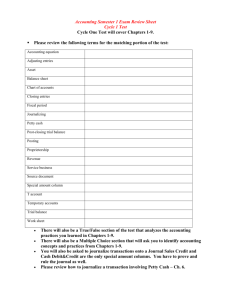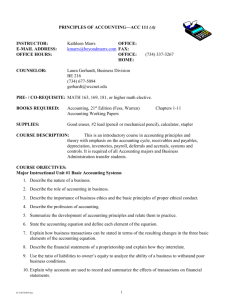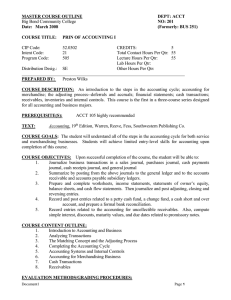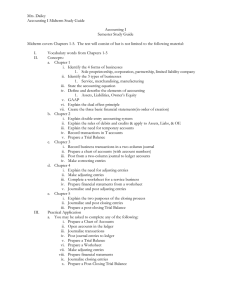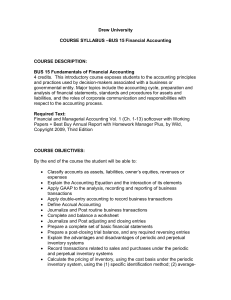YOGYAKARTA STATE UNIVERSITY FACULTY OF ECONOMICS LESSON PLAN
advertisement
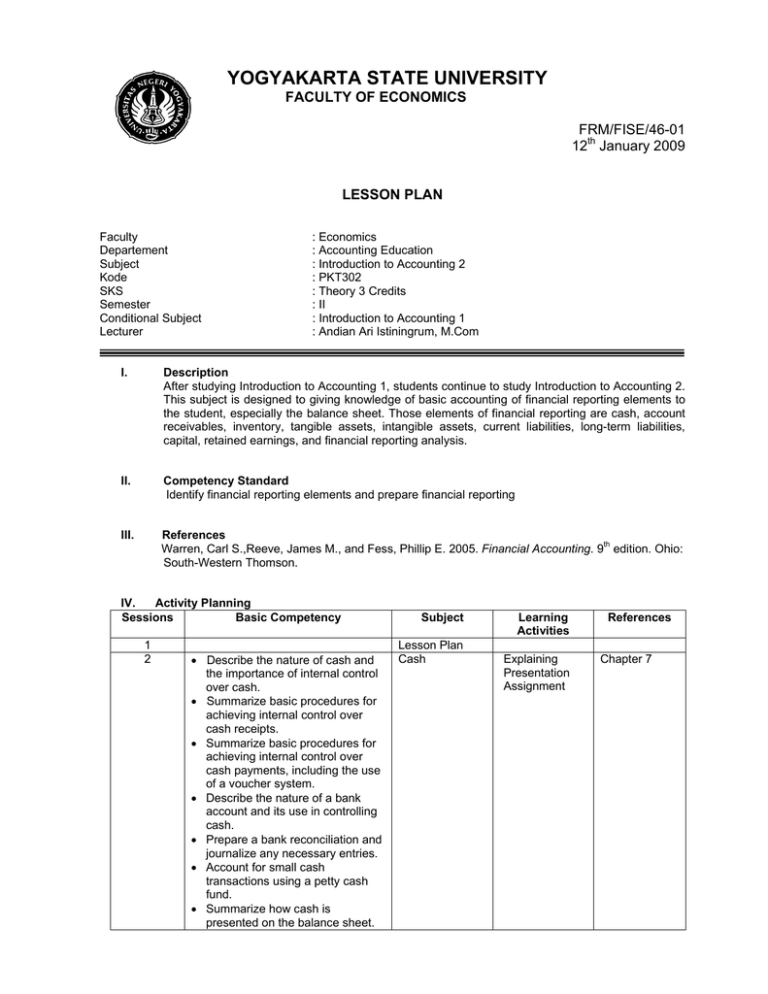
YOGYAKARTA STATE UNIVERSITY FACULTY OF ECONOMICS FRM/FISE/46-01 12th January 2009 LESSON PLAN Faculty Departement Subject Kode SKS Semester Conditional Subject Lecturer : Economics : Accounting Education : Introduction to Accounting 2 : PKT302 : Theory 3 Credits : II : Introduction to Accounting 1 : Andian Ari Istiningrum, M.Com I. Description After studying Introduction to Accounting 1, students continue to study Introduction to Accounting 2. This subject is designed to giving knowledge of basic accounting of financial reporting elements to the student, especially the balance sheet. Those elements of financial reporting are cash, account receivables, inventory, tangible assets, intangible assets, current liabilities, long-term liabilities, capital, retained earnings, and financial reporting analysis. II. Competency Standard Identify financial reporting elements and prepare financial reporting III. References Warren, Carl S.,Reeve, James M., and Fess, Phillip E. 2005. Financial Accounting. 9th edition. Ohio: South-Western Thomson. IV. Activity Planning Sessions Basic Competency 1 2 Describe the nature of cash and the importance of internal control over cash. Summarize basic procedures for achieving internal control over cash receipts. Summarize basic procedures for achieving internal control over cash payments, including the use of a voucher system. Describe the nature of a bank account and its use in controlling cash. Prepare a bank reconciliation and journalize any necessary entries. Account for small cash transactions using a petty cash fund. Summarize how cash is presented on the balance sheet. Subject Lesson Plan Cash Learning Activities Explaining Presentation Assignment References Chapter 7 Sessions Basic Competency 3 List the common classifications of receivables. Summarize and provide examples of internal control procedures that apply to receivables. Describe the nature of and the accounting for uncollectible receivables. Journalize the entries for the allowance method of accounting for uncollectibles and estimate uncollectible receivables based on sales and on an analysis of receivables. Journalize the entries for the direct write-off of uncollectible receivables. Describe the nature and characteristics of promissory notes. Journalize the entries for notes receivable transactions. Prepare the currents assets presentation of receivables on the balance sheet. Summarize and provide examples of internal control procedures that apply to inventories. Describe the effect of inventory errors on the financial statements. Describe three inventory cost flow assumptions and how they impact the income statement and balance sheet. Compute the cost of inventory under the perpetual system using the following costing methods: FIFO, LIFO, and Weighted Average. Compute the cost of inventory under the periodic inventory system using the following costing methods: FIFO, LIFO, and Weighted Average. Compare and contrast the use of the three inventory costing methods. Compute the proper valuation of inventory at other than cost using the lower of cost or market and net realizable value concepts. Prepare a balance sheet presentation of merchandise inventory. Estimate the cost of inventory using the retail method and the gross profit method. Compute and interpret the inventory turnover ratio Define fixed assets and describe the accounting for their cost. 4&5 6&7 Subject Account Receivables Learning Activities Explaining Presentation Assignment References Chapter 8 Inventory Explaining Presentation Assignment Chapter 9 Fixed Assets and Intangible Explaining Presentation Chapter 10 Sessions Basic Competency Compute depreciation using the following methods: straight-line method, units-of-production method, and declining-balance method. Classify fixed asset costs as either capital expenditures or revenue expenditures. Journalize entries for the disposal of fixed assets. Describe internal controls over fixed assets. Compute depletion and journalize the entry for depletion. Describe the accounting for intangible assets, such as patents, copy-rights and goodwill. Describe how depreciation expense is reported in an income statement and prepare a balance sheet that includes fixed assets and intangible assets. Compute and interpret the ratio of fixed assets to long-term liabilities. 8 9 10 & 11 Define and give examples of current liabilities. Prepare journal entries for shortterm notes payable and the disclosure for the current portion of long-term debt. Describe the accounting treatment for contingent liabilities and journalize entries for product warranties. Determine employer liabilities for payroll, including liabilities arising from employee earning and deductions from earnings. Journalize entries for employee fringe benefits, including vacation pay and pensions. Use the quick ratio to analyze the ability of a business to pay its current liabilities Describe the nature of the corporate form of organization. List the two main sources of stockholders’ equity. List the major sources of paid-in capital including the various classes of stock. Journalize the entries for issuing stock. Journalize the entries for treasury stock transactions. State the effect of stock splits on corporate financial statements. Journalize the entries for cash dividends and stock dividends. Subject Assets. Mid Exam Current Liabilities Corporation: Organization, Capital Stock Transactions, and Dividends Learning Activities Assignment References Explaining Presentation Assignment Chapter 11 Explaining Presentation Assignment Chapter 12 Sessions 12 & 13 14 & 15 16 Basic Competency Describe and illustrate the reporting of stockholders’ equity. Compute and interpret the dividend yield on common stock Journalize the entries for corporate income taxes including deferred income taxes. Prepare an income statement reporting the following unusual items: fixed asset impairments, restructuring charges, discontinued operations, extraordinary items, and cumulative changes in accounting principles. Prepare an income statement reporting earnings per share data. Describe the concept and the reporting of comprehensive income. Describe the accounting for investment in stocks. Describe alternative methods of combining business and how consolidated financial statements are prepared. Compute and interpret the priceearnings ratio. Compute the potential impact of long-term borrowing on the earnings per share of a corporation. Describe the characteristics of bonds. Compute the present value of bonds payable. Journalize entries for bond payable. Describe bond sinking funds. Journalize entries for bond redemptions. Journalize entries for the purchase, interest, discount and premium amortization and sale of bond investments. Prepare a corporation balance sheet. Compute and interpret the number of times interest charges are earned. Summarize the types of cash flow activities reported in the statement of cash flows. Prepare a statement of cash flows using the indirect method. Prepare a statement of cash flows using the direct method. Calculate and interpret the free cash flow. Subject Learning Activities References Income Taxes, Unsual Income Items, and Investments in Stocks Explaining Presentation Assignment Chapter 14 & 15 Bonds Payable and Investment in Bond Explaining Presentation Assignment Chapter 14 and Chapter 15 Statement of Cash Flows Explaining Presentation Assignment Chapter 16 V. Evaluation No Components Weight (%) 1 Participation 20 2 Assignment 20 3 Mid exam 30 4 Final exam 30 Total 100 th Yogyakarta, 15 Lecturer, February 2012 Andian Ari Istiningrum, M.Com 19800902 200501 2 001
